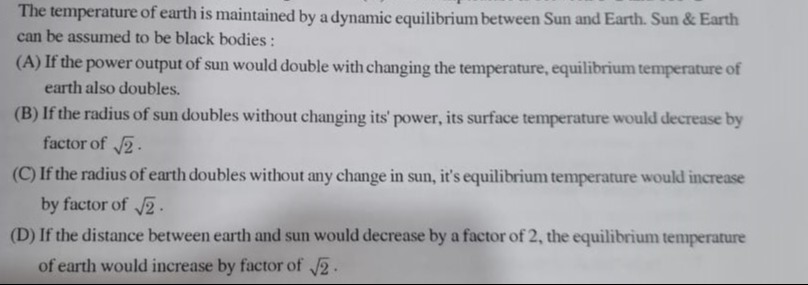Question
Question: The temperature of earth is maintained by a dynamic equilibrium between Sun and Earth. Sun & Earth c...
The temperature of earth is maintained by a dynamic equilibrium between Sun and Earth. Sun & Earth can be assumed to be black bodies :

If the power output of sun would double with changing the temperature, equilibrium temperature of earth also doubles.
If the radius of sun doubles without changing its' power, its surface temperature would decrease by factor of 2.
If the radius of earth doubles without any change in sun, it's equilibrium temperature would increase by factor of 2.
If the distance between earth and sun would decrease by a factor of 2, the equilibrium temperature of earth would increase by factor of 2.
(B), (D)
Solution
The Earth's equilibrium temperature is determined by the balance between the power absorbed from the Sun and the power radiated by the Earth. Assuming both Sun and Earth are black bodies:
The power radiated by the Sun (a black body of radius RS and surface temperature TS) is PS=4πRS2σTS4, where σ is the Stefan-Boltzmann constant.
At a distance d from the Sun, the intensity of solar radiation is IS=4πd2PS.
The Earth intercepts this radiation over its cross-sectional area πRE2. Since the Earth is assumed to be a black body, it absorbs all the incident radiation. The power absorbed by the Earth is Pabs=IS(πRE2)=4πd2PS(πRE2)=4d2PSRE2.
The Earth radiates energy as a black body with surface temperature TE over its entire surface area 4πRE2. The power radiated by the Earth is Prad=4πRE2σTE4.
In equilibrium, Pabs=Prad: 4d2PSRE2=4πRE2σTE4
We can cancel RE2 from both sides: 4d2PS=4πσTE4
Solving for TE: TE4=16πd2σPS TE=(16πd2σPS)1/4
Alternatively, substituting PS=4πRS2σTS4: 4d24πRS2σTS4=4πσTE4 d2RS2TS4=4TE4 TE4=4d2RS2TS4 TE=(4d2RS2TS4)1/4=(4)1/4(d2)1/4(RS2)1/4(TS4)1/4=2d1/2RS1/2TS.
Let's re-derive from the PS formula. TE4=16πd2σPS. TE∝PS1/4d−1/2.
Let's check the statements based on TE∝PS1/4d−1/2 and PS=4πRS2σTS4.
(A) If the power output of sun would double (PS′=2PS), equilibrium temperature of earth also doubles. TE′∝(PS′)1/4∝(2PS)1/4=21/4PS1/4∝21/4TE. TE′=21/4TE. Since 21/4≈1.189=2, the temperature does not double. Statement (A) is false.
(B) If the radius of sun doubles (RS′=2RS) without changing its' power (PS′=PS), its surface temperature would decrease by factor of 2. PS=4πRS2σTS4. PS′=4π(RS′)2σ(TS′)4. Given PS′=PS and RS′=2RS: 4πRS2σTS4=4π(2RS)2σ(TS′)4 RS2TS4=4RS2(TS′)4 TS4=4(TS′)4 (TS′)4=41TS4 TS′=(41)1/4TS=41/41TS=21TS. The surface temperature decreases by a factor of 2. Statement (B) is true.
(C) If the radius of earth doubles (RE′=2RE) without any change in sun, it's equilibrium temperature would increase by factor of 2. The formula TE=(16πd2σPS)1/4 shows that TE is independent of RE. Alternatively, the equilibrium equation 4d2PSRE2=4πRE2σTE4 shows that RE2 cancels out, so TE does not depend on RE. If RE doubles, TE remains unchanged. Statement (C) is false.
(D) If the distance between earth and sun would decrease by a factor of 2 (d′=d/2), the equilibrium temperature of earth would increase by factor of 2. TE∝d−1/2. TE′∝(d′)−1/2∝(d/2)−1/2=(d−12)1/2=2d−1/2∝2TE. TE′=2TE. The equilibrium temperature increases by a factor of 2. Statement (D) is true.
